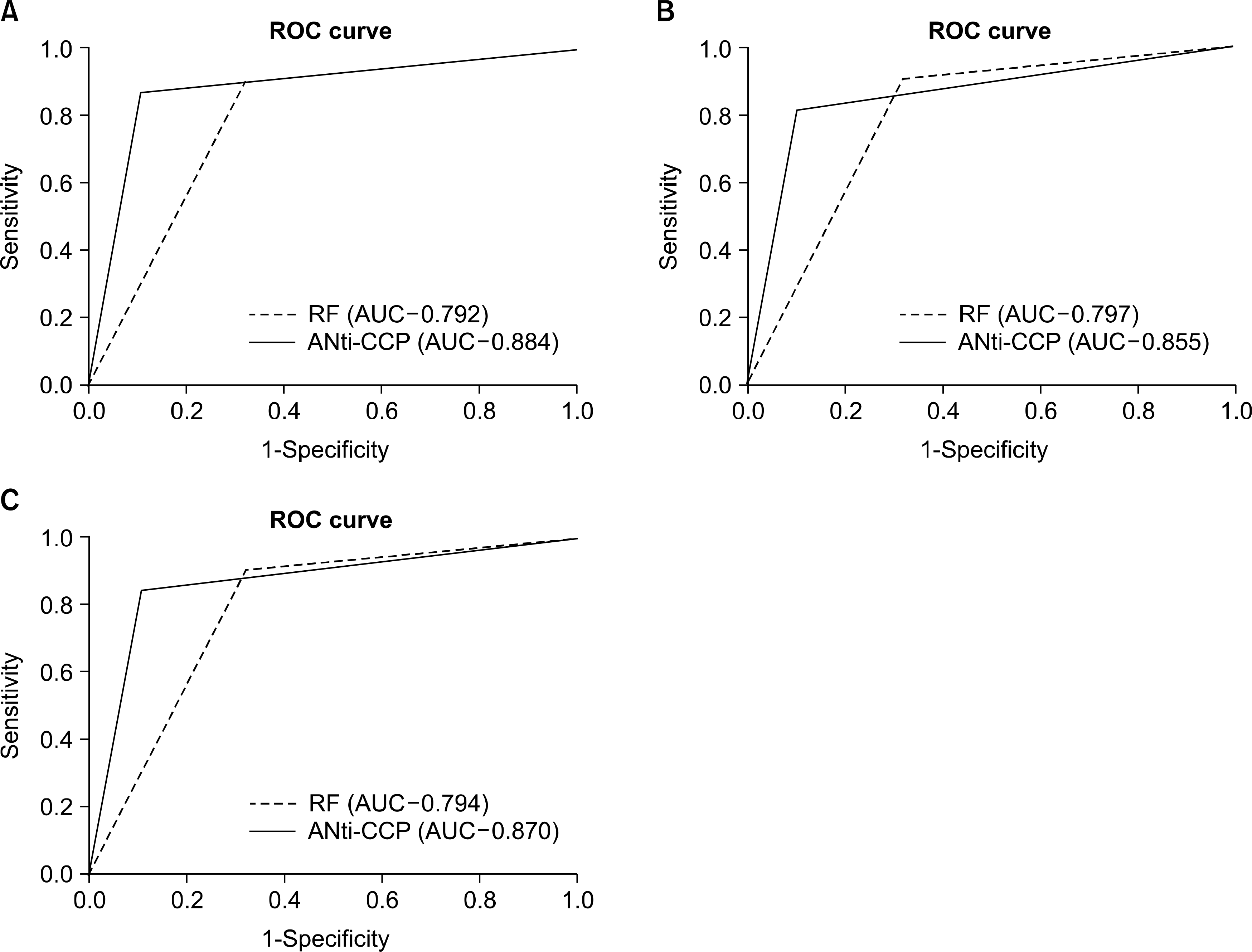1). Kvien TK. Epidemiology and burden of illness of rheumatoid arthritis. Pharmacoeconomics. 2004. 22:1–12.

2). Arnett FC., Edworthy SM., Bloch DA., McShane DJ., Fries JF., Cooper NS, et al. The American Rheumatism Association 1987 revised criteria for the classification of rheumatoid arthritis. Arthritis Rheum. 1988. 31:315–24.

3). Visser H., le Cessie S., Vos K., Breedveld FC., Hazes JM. How to diagnose rheumatoid arthritis early: a prediction model for persistent (erosive) arthritis. Arthritis Rheum. 2002. 46:357–65.

4). Avouac J., Gossec L., Dougados M. Diagnostic and predictive value of anti-cyclic citrullinated protein antibodies in rheumatoid arthritis: a systematic literature review. Ann Rheum Dis. 2006. 65:845–51.

5). 김경희, 이성원, 정원태. Association of Anti-cyclic Citrullinated Peptide (CCP) Antibodies and Functional Status in Rheumatoid Arthritis. 대한류고티스학회지. 2006. 13:46–51.
6). Forslind K., Ahlmen M., Eberhardt K., Hafstrom I., Svensson B. Prediction of radiological outcome in early rheumatoid arthritis in clinical practice: role of antibodies to citrullinated peptides (anti-CCP). Ann Rheum Dis. 2004. 63:1090–5.

7). Lindqvist E., Eberhardt K., Bendtzen K., Heinegard D., Saxne T. Prognostic laboratory markers of joint damage in rheumatoid arthritis. Ann Rheum Dis. 2005. 64:196–201.

8). Quinn MA., Gough AK., Green MJ., Devlin J., Hensor EM., Greenstein A, et al. Anti-CCP antibodies measured at disease onset help identify seronegative rheumatoid arthritis and predict radiological and functional outcome. Rheumatology (Oxford). 2006. 45:478–80.

9). Meyer O., Nicaise-Roland P., Santos MD., Labarre C., Dougados M., Goupille P, et al. Serial determination of cyclic citrullinated peptide autoantibodies predicted five-year radiological outcomes in a prospective cohort of patients with early rheumatoid arthritis. Arthritis Res Ther. 2006. 8:R40.
10). Bongi SM., Manetti R., Melchiorre D., Turchini S., Boccaccini P., Vanni L, et al. Anti-cyclic citrullinated peptide antibodies are highly associated with severe bone lesions in rheumatoid arthritis anti-CCP and bone damage in RA. Autoimmunity. 2004. 37:495–501.

11). Matsui T., Shimada K., ᄋzawa N., Hayakawa H., Hagiwara F., Nakayama H, et al. Diagnostic utility of anti-cyclic citrullinated peptide antibodies for very early rheumatoid arthritis. J Rheumatol. 2006. 33:2390–7.
12). Padyukov L., Silva C., Stolt P., Alfredsson L., Klare-skog L. A gene-environment interaction between smoking and shared epitope genes in HLA-DR provides a high risk of seropositive rheumatoid arthritis. Arthritis Rheum. 2004. 50:3085–92.

13). Emery P. The Roche Rheumatology Prize Lecture. The optimal management of early rheumatoid disease: the key to preventing disability. Br J Rheumatol. 1994. 33:765–8.
14). van der Heide A., Jacobs JW., Bijlsma JW., Heurkens AH., van Booma-Frankfort C., van der Veen MJ, et al. The effectiveness of early treatment with “second-line” antirheumatic drugs. A randomized, controlled trial. Ann Int Med. 1996. 124:699–707.
15). ᄋ'Dell JR. Therapeutic strategies for rheumatoid arthritis. New Engl J Med. 2004. 350:2591–602.
16). Nell VP., Machold KP., Stamm TA., Eberl G., Heinzl H., Uffmann M, et al. Autoantibody profiling as early diagnostic and prognostic tool for rheumatoid arthritis. Ann Rheum Dis. 2005. 64:1731–6.

17). van Aken J., Lard LR., le Cessie S., Hazes JM., Breedveld FC., Huizinga TW. Radiological outcome after four years of early versus delayed treatment strategy in patients with recent onset rheumatoid arthritis. Ann Rheum Dis. 2004. 63:274–9.

18). Nell VP., Machold KP., Eberl G., Stamm TA., Uffmann M., Smolen JS. Benefit of very early referral and very early therapy with disease-modifying anti-rheumatic drugs in patients with early rheumatoid arthritis. Rheumatology (Oxford). 2004. 43:906–14.

19). Scott DL., Symmons DP., Coulton BL., Popert AJ. Long-term outcome of treating rheumatoid arthritis: results after 20 years. Lancet. 1987. 1:1108–11.

20). Nienhuis RL., Mandema E. A new serum factor in patients with rheumatoid arthritis; the antiperinuclear factor. Ann Rheum Dis. 1964. 23:302–5.
21). Young BJ., Mallya RK., Leslie RD., Clark CJ., Hamblin TJ. Anti-keratin antibodies in rheumatoid arthritis. Br Med J. 1979. 2:97–9.

22). Vincent C., de Keyser F., Masson-Bessiere C., Sebbag M., Veys EM., Serre G. Anti-perinuclear factor compared with the so called “antikeratin” antibodies and antibodies to human epidermis filaggrin, in the diagnosis of arthritides. Ann Rheum Dis. 1999. 58:42–8.

23). Schellekens GA., de Jong BA., van den Hoogen FH., van de Putte LB., van Venrooij WJ. Citrulline is an essential constituent of antigenic determinants recognized by rheumatoid arthritis-specific autoantibodies. J Clin Invest. 1998. 101:273–81.

24). 최석우, 임미경, 신동혁, 임춘화, 심승철. 류마티스관절염환자에서Anti-cyclic citrullinated peptide antibodies 검사의진단적유용성. 대한진단검사의학회지. 2003. 2:132–8.
25). Rantapaa-Dahlqvist S., de Jong BA., Berglin E., Hallmans G., Wadell G., Stenlund H, et al. Antibodies against cyclic citrullinated peptide and IgA rheumatoid factor predict the development of rheumatoid arthritis. Arthritis Rheum. 2003. 48:2741–9.
26). Suzuki A., Yamada R., Chang X., Tokuhiro S., Sawada T., Suzuki M, et al. Functional haplotypes of PADI4, encoding citrullinating enzyme peptidylarginine deiminase 4, are associated with rheumatoid arthritis. Nature Genetics. 2003. 34:395–402.






 PDF
PDF ePub
ePub Citation
Citation Print
Print


 XML Download
XML Download